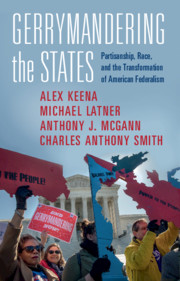Book contents
- Gerrymandering the States
- Gerrymandering the States
- Copyright page
- Contents
- Figures
- Tables
- Acknowledgments
- 1 Redistricting Wars in the US States
- 2 What Happened in 2011? The Other “Great Gerrymander”
- 3 When Politicians Draw the Maps
- 4 How Political Geography Affects Bias
- 5 Racial Geography, the Voting Rights Act, and Bias
- 6 The Policy and Social Consequences of State Legislative Gerrymandering
- 7 The Democratic Harms of Gerrymandering
- 8 When the Courts Redistrict
- 9 How to Design Effective Anti-gerrymandering Reforms
- Conclusion
- References
- Index
2 - What Happened in 2011? The Other “Great Gerrymander”
Published online by Cambridge University Press: 02 July 2021
- Gerrymandering the States
- Gerrymandering the States
- Copyright page
- Contents
- Figures
- Tables
- Acknowledgments
- 1 Redistricting Wars in the US States
- 2 What Happened in 2011? The Other “Great Gerrymander”
- 3 When Politicians Draw the Maps
- 4 How Political Geography Affects Bias
- 5 Racial Geography, the Voting Rights Act, and Bias
- 6 The Policy and Social Consequences of State Legislative Gerrymandering
- 7 The Democratic Harms of Gerrymandering
- 8 When the Courts Redistrict
- 9 How to Design Effective Anti-gerrymandering Reforms
- Conclusion
- References
- Index
Summary
Is partisan gerrymandering widespread in the state legislatures? We assess state legislative redistricting maps approved by state governments in 2011. We find results that are similar to estimates of districting bias in the US House. On average, partisan bias increased after redistricting. State governments approved more than forty state legislative redistricting plans that gave one party an extreme electoral advantage. Although we find a few examples of Democratic gerrymanders with modest levels of bias, most of the extremely biased maps favor the Republican Party. In total, there are nearly two dozen maps that award Republicans 20 percent more of the seats than Democrats when the vote is close. These extreme partisan gerrymanders give Republicans a considerable structural advantage in state legislative elections. We estimate that, in the average state legislative assembly, Republican candidates can expect to win about 9 percent more seats than Democratic candidates would for a given share of the vote, between 45 percent and 55 percent of the vote.
Keywords
- Type
- Chapter
- Information
- Gerrymandering the StatesPartisanship, Race, and the Transformation of American Federalism, pp. 14 - 49Publisher: Cambridge University PressPrint publication year: 2021



